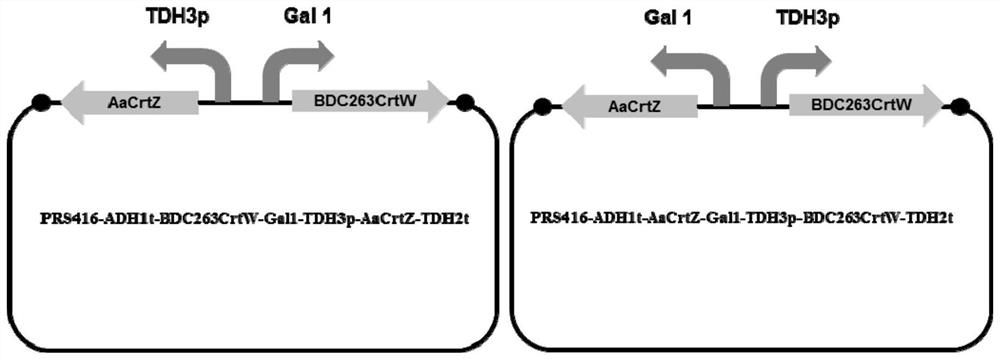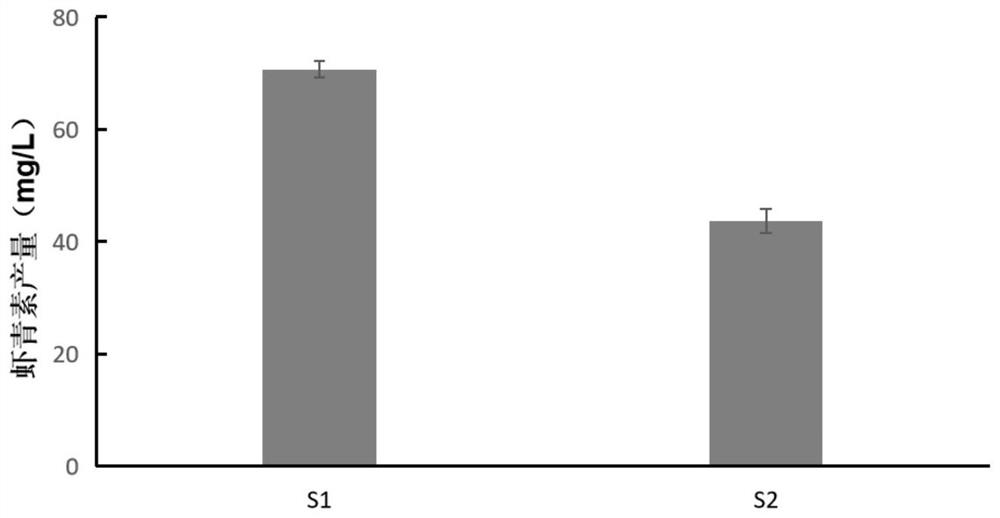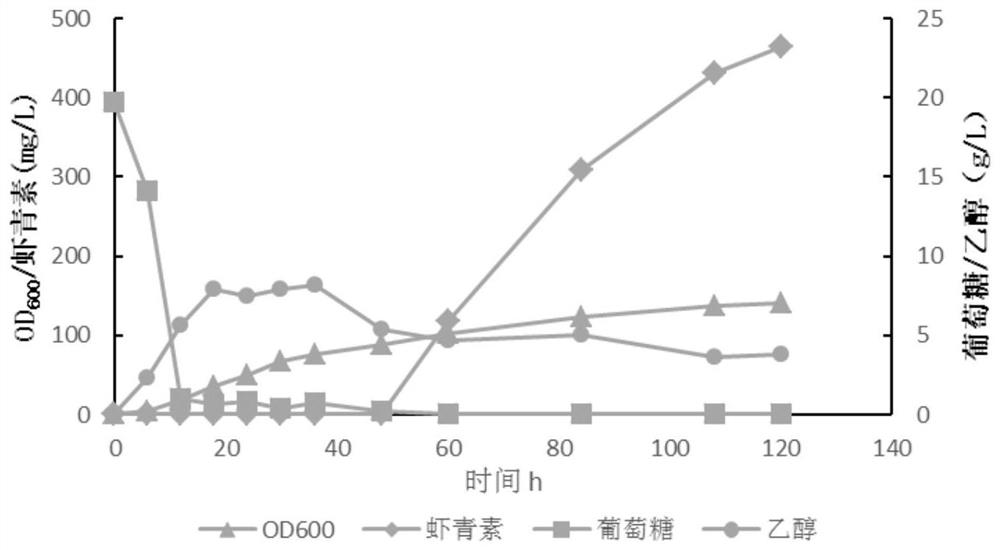Recombinant saccharomyces cerevisiae for producing astaxanthin, and application of recombinant saccharomyces cerevisiae
A technology for recombining Saccharomyces cerevisiae and Saccharomyces cerevisiae, which is applied in the field of microorganisms, can solve the problems of limiting astaxanthin production, achieve good industrial development prospects, improve metabolic flux, increase yield and purity
- Summary
- Abstract
- Description
- Claims
- Application Information
AI Technical Summary
Problems solved by technology
Method used
Image
Examples
Embodiment 1
[0042] Example 1: Construction of recombinant plasmid PRS416-ADH1t-Gal1-TDH3p-TDH2t
[0043] 1. The genomic DNA of Saccharomyces cerevisiae S228C (Saccharomyces cerevisiae S228C) was used as a template and ADH1t_F and ADH1t_R were used as primers to perform PCR amplification to obtain ADH1t. The sequence of ADH1t is shown in SEQ ID NO:3.
[0044] ADH1t_F: 5'-agctttggacttcttcgccagagg-3' (SEQ ID NO: 1);
[0045] ADH1t_R: 5'-catgccggtagagaggtgtggtcaataag-3' (SEQ ID NO: 2).
[0046] 2. Using the genomic DNA of Saccharomyces cerevisiae S228C as a template and using Gal1_F and Gal1_R as primers to perform PCR amplification to obtain Gal1, the sequence of Gal1 is shown in SEQ ID NO:6.
[0047] Gal1_F: 5'-tatagttttttctccttgacgttaaagtatag-3' (SEQ ID NO: 4);
[0048] Gal1_R: 5'-ttatattgaattttcaaaaattcttactttttttttggatgg-3' (SEQ ID NO: 5).
[0049] 3. Using the genomic DNA of Saccharomyces cerevisiae S228C as a template and using TDH3p_F and TDH3p_R as primers to perform PCR amplifica...
Embodiment 2
[0068] Example 2: Insertion of foreign genes
[0069] 1. Using the AaCrtZ gene as a template and using Primer 5_F and Primer 5_R as primers to perform PCR amplification to obtain BsaI-AaCrtZ-BsaI, the sequence of BsaI-AaCrtZ-BsaI is shown in SEQ ID NO: 25, and the AaCrtZ gene is shown in SEQ ID NO: 25 Shown in the 9-497 position.
[0070] Primer 5_F: 5'-ggtctccaatgactaacttcttgatcgttgttg-3' (SEQ ID NO: 23);
[0071] Primer 5_R: 5'-ggtctccattaagttctttcttgagcttcag-3' (SEQ ID NO: 24).
[0072] 2. Using the BDC263CrtW gene as a template and using Primer 6_F and Primer 6_R as primers to perform PCR amplification to obtain BsaI-BDC263CrtW-BsaI, the sequence of BsaI-BDC263CrtW-BsaI is shown in SEQ ID NO: 28, and the BDC263CrtW gene is shown in SEQ ID NO: 28 in the 9-734 shown.
[0073] Primer 6_F: 5'-ggtctccaatgtccgctgttactccaatg-3' (SEQ ID NO: 26);
[0074] Primer 6_R: 5'-ggtctccattattgaaaataaagaccaccaaggc-3' (SEQ ID NO: 27).
[0075] 3. Using the AaCrtZ gene as a template and u...
Embodiment 3
[0086] Example 3: Construction of recombinant yeast strains producing astaxanthin
[0087] The recombinant expression vectors PRS416-ADH1t-AaCrtZ-Gal1-TDH3p-BDC263CrtW-TDH2t and PRS416-ADH1t-BDC263CrtW-Gal1-TDH3p-AaCrtZ-TDH2t obtained in Example 2 were transformed into strains producing β-carotene by the lithium acetate method Scy10026 Saccharomyces cerevisiae, and through SC-Ura solid medium (synthetic yeast nitrogen source YNB 6.7g / L, glucose 20g / L, mixed amino acid powder 2g / L excluding uracil, 2% agar powder) Transformants were screened to obtain astaxanthin-producing recombinant Saccharomyces cerevisiae strains S1 and S2, respectively.
[0088] The construction method of the Scy10026 Saccharomyces cerevisiae is as follows: transfer the CYC1t-BtCrtI-HXT7p-TDH3p-PaCrtB-ADH1t fragment (SEQ ID NO: 37) into Saccharomyces cerevisiae S288C, perform homologous recombination and replace gal1, gal7, gal10 genes, and integrate into On the chromosome; then transfer the CYC1t-PaCrtY-...
PUM
 Login to View More
Login to View More Abstract
Description
Claims
Application Information
 Login to View More
Login to View More - R&D
- Intellectual Property
- Life Sciences
- Materials
- Tech Scout
- Unparalleled Data Quality
- Higher Quality Content
- 60% Fewer Hallucinations
Browse by: Latest US Patents, China's latest patents, Technical Efficacy Thesaurus, Application Domain, Technology Topic, Popular Technical Reports.
© 2025 PatSnap. All rights reserved.Legal|Privacy policy|Modern Slavery Act Transparency Statement|Sitemap|About US| Contact US: help@patsnap.com



